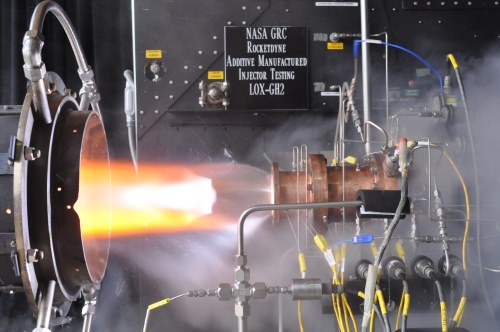
NASA tests this 3D-printed rocket engine injector. (Image via Glenn Research Center)
Last we checked on NASA’s 3D-printing front, astronauts could soon be eating 3D-printed pizza. Now, 3D printing is bringing NASA one step closer to a 3D-printed spacecraft.
Last week, NASA tested the first 3D-printed rocket engine injector at the Glenn Research Center in Cleveland, OH.
The rocket engine component that consists of liquid-oxygen and gaseous hydrogen was able to withstand high-pressure fire tests.
Aerojet Rocketdyne worked in conjunction with NASA to design the injector through a method that uses high-powered laser beams to melt and fuse fine metallic powders into three-dimensional structures.
The implementation of this new space technology could lead to more efficient and low-cost production of rocket engines.
“Rocket engine components are complex machined pieces that require significant labor and time to produce. The injector is one of the most expensive components of an engine,” said Tyler Hickman, the NASA engineer who led the testing.
A traditional (non-3D-printed) rocket engine injector would take over a year to create. The 3D-printing method allows for a four-month building time and cuts the cost by 70%.
“Hot fire testing the injector as part of a rocket engine is a significant accomplishment in maturing additive manufacturing for use in rocket engines,” said Carol Tolbert, manager of the Manufacturing Innovation Project at Glenn. “These successful tests let us know that we are ready to move on to demonstrate the feasibility of developing full-size, additively manufactured parts.”
It looks like 3D-printing is moving space travel toward a new age of printed rocket ships to transport our astronauts.
For more information visit NASA.
Advertisement
Learn more about Electronic Products Magazine





